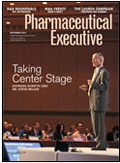2014: Reading Between the Lines
THE CALENDAR SAYS IT'S WRAP UP TIME, not just for gifts, but for some of the trends that shaped big Pharma-for good or bad-during the past year. A simple way to close the book on 2014 is to draw some insights from our three feature stories this month.

THE CALENDAR SAYS IT'S WRAP UP TIME, not just for gifts, but for some of the trends that shaped big Pharma-for good or bad-during the past year. A simple way to close the book on 2014 is to draw some insights from our three feature stories this month. Whether by design or circumstance, our efforts reveal the random diversity of threats and opportunities facing the industry today.
Certainly the cast of players that bears watching is growing larger and less predictable. Our cover profile on Express Scripts Chief Medical Officer Dr. Steve Miller is a lesson on how splendid isolation cannot be a winning strategy for big Pharma today. Interdependency may not induce harmony either, but it is necessary, nonetheless, if only because a stakeholder with buying power for 85 million covered lives carries a big stick. You might call Miller a disruptive innovation in himself, with a publicly adversarial posture that has him refusing to walk softly within the well-worn treads of the drug industry's pricing model. Personalities aside, it's a clear departure for a low-profile company that labored in obscurity as it grew its revenues to exceed those of all the top 10 big Pharma players today.
In a lengthy interview, Miller touts his background as a medical researcher and lays out a four-point plan to improve cooperation with R&D drugmakers. His objective is to boost the efficiency of drug development and thus lower the cost of new breakthroughs, particularly in high-demand specialty categories. Competitive self-interest is the driver here: with most generics commoditized and fewer patent expiries on the horizon, Express Scripts' value proposition to its own customers-some 4,000 plan sponsors-must skew heavily toward control of their exposure to higher priced biologics. Given the large ongoing investments PBMs must make in servicing these plans, book retention rates are as important to them as free pricing is to big Pharma.
Miller's offer merits some kicking of the tires to test its credibility in the broader policy arena. And there are examples of mutually productive contacts, like a recent deal with Sanofi, where the two companies agreed to share data to guide the conduct of clinical trials and build real-world evidence from post-marketing studies. The proviso is that relations require, from the big Pharma side, careful internal alignment around a negotiating stance that can anticipate any number of scenarios, from good to catastrophic. Relevant is Sanofi's own stumble on "price protection" as a condition for securing Express Scripts' formulary coverage for its all-important US diabetes franchise, a lock hold on future profitability widely assumed as a factor behind the sudden departure of CEO Chris Viehbacher in October. The prompt for PBM contacts in 2015? Trust but verify, and stay close.
Next is PE's annual review of industry M&A activity, conducted with Editorial Advisory Board member Young & Partners. The record numbers, aptly described as "frenzied," are motivated by a bewildering array of company responses to changing market conditions. But the statistics also mark the arrival of a new stakeholder with the clout to shift the industry trajectory: the financial activist, who sees opportunity not in the science but in the scaffolding around obscure accounting terms like EBITDA. The evidence this year is that profits from market manipulations can match the rewards from great medicines. The $2.6 billion gain posted by hedge fund activist Bill Ackman of Pershing Square Capital Management, as a consequence of his months-long legal assault on Allergan to steer it to a shotgun marriage with serial acquirer Valeant, just about equaled the revenue earned by Gilead Sciences on its miracle HCV cure Sovaldi during the same period. Does money follow the patient, as health economists like to say? Not anymore, apparently.
Third on our list this month is an Executive Roundtable on how companies are upgrading the role of project management to speed the transition from drug development to commercialization. Here, we learn what might be the single-most important lesson from the market churn that characterized the year now ending: the need for focus, at every stage of the decision chain. Participants touted learnings from other sectors, like automobiles, where process efficiencies have shortened the turnaround time to new product introductions, with a powerful impact in concentrating the minds of teams that manage the pathways from development to launch. The big question for big Pharma is, recognizing that its own lead times are always going to be longer, how do you keep the troops engaged, disciplined and on target-for the duration?
Manage that transition well, and the rest will fall into place.
William Looney Editor-in-Chief wlooney@advanstar.com
Follow Bill on Twitter: @BillPharmExec

Asembia 2025: Therapy Advancements Highlight Growing Cost and Access Concerns
April 30th 2025Fran Gregory, VP, emerging therapies, Cardinal Health, discusses the evolving cell and gene therapy landscape, highlighting pipeline growth, cost challenges, and emerging therapeutic areas beyond oncology and hematology.
Addressing Disparities in Psoriasis Trials: Takeda's Strategies for Inclusivity in Clinical Research
April 14th 2025LaShell Robinson, Head of Global Feasibility and Trial Equity at Takeda, speaks about the company's strategies to engage patients in underrepresented populations in its phase III psoriasis trials.
FDA Approves Nipocalimab for the Treatment of Generalized Myasthenia Gravis
April 30th 2025Approval is based on results from the pivotal Vivacity-MG3 trial in which IMAAVY (nipocalimab-aahu) demonstrated superior disease control throughout 24 weeks when compared to placebo plus standard of care.
Beyond the Prescription: Pharma's Role in Digital Health Conversations
April 1st 2025Join us for an insightful conversation with Jennifer Harakal, Head of Regulatory Affairs at Canopy Life Sciences, as we unpack the evolving intersection of social media and healthcare decisions. Discover how pharmaceutical companies can navigate regulatory challenges while meaningfully engaging with consumers in digital spaces. Jennifer shares expert strategies for responsible marketing, working with influencers, and creating educational content that bridges the gap between patients and healthcare providers. A must-listen for pharma marketers looking to build trust and compliance in today's social media landscape.
FDA Approves AbbVie’s Rinvoq as First Oral JAK Inhibitor for Giant Cell Arteritis
April 30th 2025AbbVie secures FDA approval for Rinvoq as the first oral Janus kinase inhibitor indicated for giant cell arteritis, expanding its immunology portfolio and signaling strategic growth opportunities in underserved autoimmune markets.